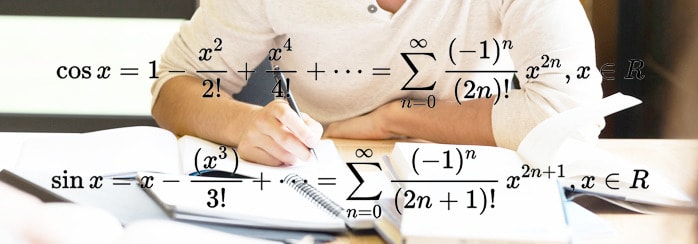How often do you face the problem of memorizing different math formulas, rules, and equations? Consider this boring? We have another option that will make you more interested in the subject. How about rap? It is easy to listen to and to keep in mind lyrics, moreover, lots of us are simply fond of it. Why do we speak about this? Here we’ll show you, how to combine rap and math! Continue reading
Math - Page 4
Find Probability of 64th Head in 99th Toss of Fair Coin
Let’s discuss how to find probability using multiplication rule and classical definition of probability. Consider the following problem. Suppose we’re asked to find a probability of obtaining 64^{th} head in the 99^{th} toss of fair coin. At the first glance the problem seems rather complicated, doesn’t it? Analyze carefully this question. In fact, we can divide the problem into two stages Continue reading
Constructing Taylor series for Sine and Cosine
Taylor series is used for approximation of functions. Check our article about Taylor series if you need more details. As you know, often general formula is not enough for solving problems. There’s no need in reinventing the bicycle each time, when you face one of common functions. More profitable way is to memorize a few expansions and use ready formulas when required. Previously we’ve considered Taylor expansions for exponential and logarithm (click here fore details). Let’s proceed and find formulas for sine and cosine.
How to Construct Taylor Series for Exponential and Logarithm
Recently we’ve discussed what Taylor series is (check our article for more information). In practice, it’s useful to know certain expansions of elementary functions. It’s like a table of derivatives or integrals. If you have it, you’re saving your time in calculations. The case of particular interest is the expansion of function in the vicinity of x=0. Such series is called MacLaurin expansion, and that’s what we’re going to consider for the cases of some common functions. Maclaurin series of elementary functions is widely used and appears frequently in math tasks, so today we’ll obtain it for exponential and logarithmic functions. Continue reading
What is Taylor Series
Suppose you need to calculate \sin{138} and don’t have a calculator at hand. How’d you do that? The way out is to approximate your function with something more convenient to work with, for example, polynomials: x, x^2, x^3 and so on. In this section, we’re going to discuss Taylor series which is an expansion of function into infinite sum of power functions. The series is called in honor of English mathematician Brook Taylor, though it was known before Taylor’s works. Taylor series is applied for approximation of function by polynomials. Such approach allows to replace initial more or less complicated function with the sum of simpler ones. Let’s get started. Continue reading
How to Apply Chain Rule and Quotient Rule Simultaneously?
Previously we’ve discussed the chain rule for derivatives and how to apply it. However, sometimes using chain rule alone is not enough and you’re also required to apply other rules for derivatives to get the correct answer. Today we’ll consider one of such cases. Continue reading
Chain Rule: Finding Derivatives Example
 Taking a calculus class, you’ll surely be asked to find derivatives of functions. Sometimes it’s not that easy to do. If your function is not among common ones, you need to apply special rules to find its derivative: product rule, quotient rule, chain rule, etc. In this section we’re going to show you an example of using chain rule. Suppose we need to find the first derivative of the following function:
Taking a calculus class, you’ll surely be asked to find derivatives of functions. Sometimes it’s not that easy to do. If your function is not among common ones, you need to apply special rules to find its derivative: product rule, quotient rule, chain rule, etc. In this section we’re going to show you an example of using chain rule. Suppose we need to find the first derivative of the following function:
h(x)=(2x^2+3)^{10}
In fact, in this particular case, we can just open the braces using binomial theorem and obtain a polynomial, derivative of which is easily found due to table of derivatives. But not that fast, we have 10th power and opening the braces would be a troublesome business. So let’s try to use chain rule instead, you’ll appreciate simplification it suggests. Continue reading










